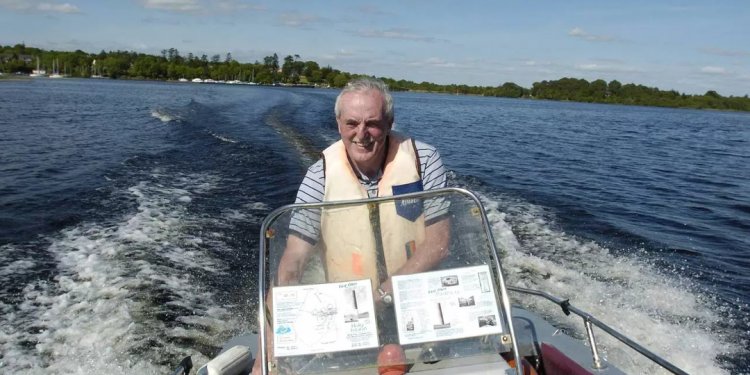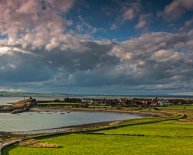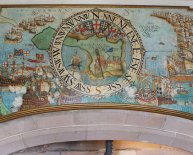 After the full time once the Celtic Christian saint St. Molaise lived regarding the area at the conclusion of the 6th century, it became known as Eilean Molaise, that is Gaelic for 'Molaise's Island'. This title slowly evolved during the period of hundreds of years until at the beginning of the nineteenth century the island became often known as Holy Isle (and/or Holy Isle) plus the town on the other hand associated with the bay became referred to as Lamlash.
After the full time once the Celtic Christian saint St. Molaise lived regarding the area at the conclusion of the 6th century, it became known as Eilean Molaise, that is Gaelic for 'Molaise's Island'. This title slowly evolved during the period of hundreds of years until at the beginning of the nineteenth century the island became often known as Holy Isle (and/or Holy Isle) plus the town on the other hand associated with the bay became referred to as Lamlash.
Saint Molaise (566 - 640 A.D.)
St. Molaise came to be in Ireland, the boy of Cairell, the Irish master of what's now known as Ulster, as well as the Scottish princess Gemma. Molaise had been a really gifted and spiritually likely youngster. He was favorite by his or her own individuals and ended up being offered the throne of Ulster when he arrived old, but instead he decided a religious and secluded life in a cave in the west coast of Holy Isle. He was after that just twenty years old. Some individuals genuinely believe that when St. Molaise find the cave on Holy Isle as his hermitage, the area was already considered an unique, "holy" destination.
When he was about three decades old, Molaise went along to Rome and had been ordained as a priest by Pope Gregory the fantastic. As he came back, he joined the fantastic monastery in Leighlin, Ireland which St. Gobban had founded. Soon after he became its abbot. Under his guidance the monastery grew in fame and quantity to about 1500 monks. Molaise played a significant part in following the controversial Roman way of dating Easter within Ireland. It was an important concern among the list of different Christian churches, just who debated it for a couple of hundreds of years. Whenever Molaise was at their belated 50s, he returned to Rome and ended up being consecrated very first Bishop of Leighlin by Honorius I. Historians are divided on whenever Molaise died, estimating between 638 and 641. Their feast time is celebrated in both Ireland and Scotland, in the eighteenth of April.
 St. Molaise's cave and Healing Well
St. Molaise's cave and Healing Well
The cave in which St. Molaise existed, is all about half way across the western shore of Holy Isle, about ten yards over the high-water mark, and is comprised of an overhanging sandstone rock with a sunken rock floor. It's believed that in Molaise's time a lot of the orifice regarding the cave was shut up by a wall to keep the current weather out. The cave can still be visited these days. Carvings is visible into the wall, eg simple crosses, perhaps created by pilgrims, and Norse runes, mainly of personal names. One of these brilliant claims "Vigleikr the Marshall carved". A few of the crosses seem to have already been created at across the same time once the brands, so perhaps there was some pilgrimage into the cave among the Vikings. Finally, there is certainly an unusually created cross carved in to the roofing associated with cave.
Near The cave is a springtime, known as the Healing Well which is considered to heal ills and bring blessings. When you look at the 18th century it had been taped that "the natives used to take in and bath in [the well] for several ongoing illnesses". The same origin describes water as "gushing off a rock". At the beginning of the twentieth century apparently there was a cistern current built of masonry, with a stone spout which delivered the water. The spring is overgrown today to make sure you wouldn't have more than a footbath as a result however the water continues to be cold and obvious, albeit it generally does not satisfy current EU criteria for drinking water.
 The Monastery
The Monastery
There are several indications of a monastery having been around on Holy Isle, most likely near something now the Centre at north-end. It may have already been erected at the beginning of the 13th century, although various other resources state it absolutely was in 14th century. The monastery structures could have been manufactured from timber or a dry-built framework which left no traces. In the 16th century it is often recorded to have decayed.
The Vikings
In 1263 King Haakon of Norway introduced a fleet of vessels into shelter of Lamlash Bay, before fighting the Scots at Battle of Largs. Vigleikr, one of his marshals, went ashore at Holy Isle and slashed runes together with his title on the wall surface of St. Molaise's cave. After the fight, King Haakon offered the island of Arran to 1 of his supporters, but this really don't count for a lot after the Norse had departed.
The Dukes of Hamilton
In 1488 Holy Isle and land when you look at the Lamlash location ended up being owned by one John Hunter, before being passed to the Earl of Arran in 1527. The area stayed an element of the Arran Estate in Hamilton ownership also into the 20th century, becoming rented off to numerous people until that point. In eighteenth century, Captain James Hamilton (perhaps not pertaining to the dukes of Hamilton just who had Arran) received a lengthy lease on Holy Isle from the Duke of Hamilton. In 1779 he built just what became referred to as Big House (the old farmhouse, today called the Harmony Wing).
 Lighthouses
Lighthouses
In 1877 the inner lighthouse (dealing with Arran) ended up being built on Holy Isle, engineered by David and Thomas Stevenson. Its in your area known as "Wee Donald", though the current lighthouse keepers have no idea the reason why any longer. The exterior lighthouse, or Pillar Rock, had been built in 1905 on the east coast. It had a fog horn and a revolving light which was illuminated by paraffin. Pillar Rock lighthouse ended up being the very first lighthouse designed with a square tower and contains a number of spaces inside the males whom worked truth be told there. Lighthouse cottages were built to house four categories of the lighthouse keepers and a walled garden ended up being made. The lighthouses became automatic in 1977, and tend to be now serviced every a couple of weeks by local people living on Arran.
The "Wealthy US"
In 1957 the Duchess of Montrose passed away and demise duties were excessive that the Arran home needed to be divided. An element of the land ended up being passed away into Forestry Commission together with nationwide Trust, whilst other parts moved into private fingers. Holy Isle received a life tenant in 1958: Stewart Huston of Pennsylvania, American. He had been a millionaire who'd a unique interest in the area because he had been descended from Gershom Stuart, who was Minister of Kilbride (at Lamlash) from 1747 - 1796. Despite their interest in the island and its own history, he would not visit often, as well as the land stayed useful for grazing sheep by regional shepherds from Arran.
The Universities Federation for Animal WTelfare
In 1968, the UFAW (Universities Federation for Animal Welfare) ended up being expected to advise from the husbandry and management of the island's animals, which at that moment contains Blackface sheep and a herd of feral goats. They setup a Field research Centre in 1969, and after Stewart Huston passed on, they were able to buy the island in 1971. in old age they launched 25 Soay sheep and 5 Highland cattle, and some years later 5 Eriskay ponies. Once the UFAW could not any longer manage to keep it, the island needed to be sold once again.
The Morris Family
In April 1984, after having already been in the marketplace for 20 months, the island was bought by James and Catherine Morris for £120, 000. They relocated to the farmhouse here summertime due to their two young sons. They been able to link electricity through the south end towards the north, which made residing in the farmhouse convenient for all of them. In 1990 all the Highland cattle and seven ponies had been removed the island, leaving the Saanen goats, the Soay sheep and five Eriskay ponies.
Source: holyisland.org

 After the full time once the Celtic Christian saint St. Molaise lived regarding the area at the conclusion of the 6th century, it became known as Eilean Molaise, that is Gaelic for 'Molaise's Island'. This title slowly evolved during the period of hundreds of years until at the beginning of the nineteenth century the island became often known as Holy Isle (and/or Holy Isle) plus the town on the other hand associated with the bay became referred to as Lamlash.
After the full time once the Celtic Christian saint St. Molaise lived regarding the area at the conclusion of the 6th century, it became known as Eilean Molaise, that is Gaelic for 'Molaise's Island'. This title slowly evolved during the period of hundreds of years until at the beginning of the nineteenth century the island became often known as Holy Isle (and/or Holy Isle) plus the town on the other hand associated with the bay became referred to as Lamlash. St. Molaise's cave and Healing Well
St. Molaise's cave and Healing Well
 The Monastery
The Monastery Lighthouses
Lighthouses






